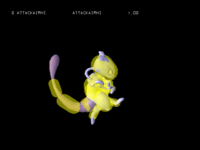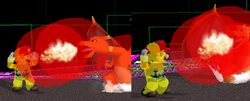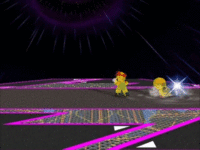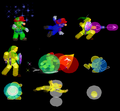Hitbox

A hitbox or collision bubble (sometimes hitbubble) is the main structure for how attacks are executed in most fighting games. Attacks have one or more hitboxes associated with them, and when these hitboxes overlap with a target's damagable area (sometimes called their hurtbox or hurtbubbles), the attack is considered a hit. Hitboxes are invisible and usually, though not always, have the same shape as the attack's animation.
Overview
The two most common forms of hitbox shapes in video games are cuboids and spheres. Neither is obviously better than the other - cuboids can more easily form long or thin attacks or targets, while spheres are easier to calculate collision detection for. Smash 64 uses cuboids whereas Melee and Brawl use spheres and sphere-like structures known as capsules (cylinders with spheres on the ends).
In Smash 64, hacks can enable hitbox visibility (with a few limitations), such as in this image. In Melee, hitboxes can be seen using Debug Mode. There is no easy way to display hitboxes in-game in Brawl, though a common technique is to use hacks to place Super Scope shot visuals where the hitboxes are (which is significantly more involved a process and generally fails for any projectile or item).
Should multiple hitboxes of a single move connect with the opponent, only one of them will count. The order of precedence is known as the "hitbox stack" - hitboxes higher in the stack will override ones lower should they both hit at the same time. Mechanically, this is denoted by giving each hitbox an ID number, and lower numbers indicate higher precedence (higher stack position). For example, Marth's down aerial in Melee features its tipper hitbox on top of the stack, so hitting with both a tipper and non-tipper hitbox will result in the tipper counting (even if the majority of the opponent was hit by the other hitboxes). By contrast, the move in Brawl has the tipper on the bottom, so the tipper can only hit if none of the other hitboxes do. As a result, even through the sizes and positions of the hitboxes did not change much between games, the tipper is simple to hit with in Melee while being difficult in Brawl.
Hitboxes that are separated from a character's hurtboxes are often called disjointed, which is usually an advantage, as they can connect from a farther distance, while keeping the attacker safer from retaliation and reducing the likelihood of trading blows. Examples of disjointed hitboxes include most weapon-based attacks, as well as the up tilts of Kirby (in Smash 64) and Snake.
An interesting property of hitboxes in the Smash Bros. series is that under most conditions, they occupy not only the space where they currently are, but also the space where they were one frame ago as well as all the space in between (in a straight line, regardless of what the animation might look like during intervening subframes). This characteristic is likely to prevent situations where a fast projectile may end up passing through a character in less than a frame without hitting them. On the other hand, hurtboxes do not stretch over "interframe space" in this way, so a fast-moving object (such as Fox during his Illusion) may be able to move through a slow or stationary hitbox without being damaged. In addition, certain hitboxes in Brawl use the stretch effect to create a very long hitbox, for example in Zero Laser and Aura Storm, instead of stretching over interframe space. It is unclear how the hitbox-stretching mechanism operates in Brawl when time is slowed via training mode or other effects, as Brawl renders subframes, whereas Melee and SSB64 simply reduce the overall framerate.
It is a common misconception that, like some other fighting games, hitboxes and hurtboxes only operate in two dimensions. In actuality, they interact in all three dimensions equally, and there are many situations where certain animations can bring some of a character's hurtboxes outside the line of fire for many attacks (such as the end of King Dedede's sidestep).
Hitbox types
| Hitbox Type | Debug Mode Colour | Explanation |
|---|---|---|
| Offensive | Red | The standard type of attacking hitbox. In Brawl, there are various types of offensive hitboxes, some of which have unique abilities (like the ability to ignore shields). |
| Damageable | Yellow | The standard type of damageable area, also known as hurtboxes. Characters have a variety of these attached to their bodies, while damageable stage areas (such as the wedge of ice on the Summit) use them as well. |
| Invincible | Green | Invincible targets can be hit by attacks but will not flinch or take any damage or knockback. For example, this occurs for characters that have just stepped off a revival platform, or who have used a Star. |
| Intangible | Blue | Intangible targets cannot be hit by attacks. This occurs during dodges and rolls. Various characters have attacks which provide parts of their body with intangibility, such as Mario's head during his up smash. |
| Reflective | Aqua | Defensive hitboxes that reflect attacks. |
| Shield | Cyan | Defensive hitboxes that shield attacks. |
| Absorbing | Cyan-blue | Defensive hitboxes that absorb attacks. |
| Grab | Magenta | Grab hitboxes will ignore any special or defensive hitboxes. |
| Inert | Grey | Inert hitboxes are used for collision detection when a regular hitbox is unsuitable (such as the dash of Raptor Boost). |
Hitbox properties
| Property | Introduced in | Description |
|---|---|---|
| Damage | Smash 64 | The base damage dealt by the hitbox. Always an integer, but once modified by things like stale-move negation, rarely ends up as one. |
| Angle | Smash 64 | The direction the target is sent flying. Usually a number from 0 to 360, with numbers such as 361 or 365 indicating the Sakurai angle or autolink angle. Can also be negative numbers such as -90. |
| Base knockback | Smash 64 | The minimum knockback this hitbox can apply, regardless of target's weight and damage (but dependent on type effectiveness and damage ratio). |
| Knockback growth | Smash 64 | Modifies how much knockback rises as the target's damage increases, with the default being 100. For example a value of 110 means that knockback will increase at a 1.1x rate compared to other hitboxes that deal the same damage. |
| Fixed knockback value | Smash 64 | If set, causes the hitbox to deal the same knockback regardless of the target's damage. |
| Effect | Smash 64 | Determines what happens when the hitbox connects: nothing, slashing, burning, electrocution, etc. |
| Groundness/Airness | Smash 64 | Determines whether a hitbox can strike grounded opponents, aerial opponents, or both. |
| Shield damage | Smash 64 | Modifies how much damage the hitbox does to shields. |
| Clang | Smash 64 | Determines whether a hitbox can cancel out other hitboxes through priority rules. |
| Sound effect | Smash 64 | On impact, each hitbox produces a sound effect with a given type (punch, kick, slash, shock, burn, etc.) and severity (small, medium, large; in Brawl huge is introduced for certain types). |
| Reflectiveness | Smash 64 | Determines whether the hitbox can be reflected. |
| Absorptiveness | Smash 64 | Determines whether the hitbox can be absorbed. |
| Blockability | Melee? | Determines whether the hitbox can be shielded. |
| Rebound | Melee | Determines whether a move is interrupted when it clangs with another move. |
| Type | Brawl | Determines what kind of stickers can power up the attack: arm, leg, body, weapon, etc. |
| SDI Multiplier | Brawl | Modifies how much smash directional influence can be applied when struck by this hitbox. |
| Freeze frames multiplier | Brawl | Changes how many freeze frames are applied on impact. |
| Trip chance | Brawl | Gives the hitbox an extra chance of tripping opponents. |
| Directness | Brawl | Determines whether the hitbox is Specials: Indirect. |
| Angle Flipper | Brawl | Sets whether a hitbox is allowed to hit targets the opposite direction if the target is behind the attacker, among other things. |
Trapbox
A trapbox is the hitbox left on the ground during Ness' Yoyo Glitch. It is called a trapbox because this hitbox is not attached at all to any kind of attack but instead just sits wherever it was when the glitch occured. Using a new attack will overwrite the hitbox with the new attack's properties and relocate it to the new attack, which due to the interframe stretching effect will cause it to hit everything between it and Ness.
Trivia
- In SSB64, grabs are normal hitboxes with no apparent mechanism for distinction from attacks. In Melee, grab hitboxes and inert hitboxes are 0%-damage hitboxes with "grab" or "inert" for an effect. Both grabs and inert hitboxes are separate objects in Brawl, though in rare cases a 0%-damage hitbox is used as an inert one.
Gallery
The hitboxes of Kirby's forward tilt, with Kirby's collision boxes, in the original game.
An example of a hack used to show the hitboxes of Toon Link's Spin Attack in Brawl.




